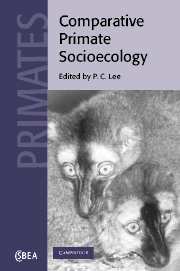Book contents
- Frontmatter
- Contents
- List of contributors
- Preface
- Part 1 Comparative methods
- Part 2 Comparative life history and biology
- 4 Socioecology and the evolution of primate reproductive rates
- 5 Comparative ecology of postnatal growth and weaning among haplorhine primates
- 6 Some current ideas about the evolution of the human life history
- 7 The evolutionary ecology of the primate brain
- 8 Sex and social evolution in primates
- 9 Mating systems, intrasexual competition and sexual dimorphism in primates
- Part 3 Comparative socioecology and social evolution
- Editor's conclusion: Socioecology and social evolution
- Index
9 - Mating systems, intrasexual competition and sexual dimorphism in primates
Published online by Cambridge University Press: 24 August 2009
- Frontmatter
- Contents
- List of contributors
- Preface
- Part 1 Comparative methods
- Part 2 Comparative life history and biology
- 4 Socioecology and the evolution of primate reproductive rates
- 5 Comparative ecology of postnatal growth and weaning among haplorhine primates
- 6 Some current ideas about the evolution of the human life history
- 7 The evolutionary ecology of the primate brain
- 8 Sex and social evolution in primates
- 9 Mating systems, intrasexual competition and sexual dimorphism in primates
- Part 3 Comparative socioecology and social evolution
- Editor's conclusion: Socioecology and social evolution
- Index
Summary
Many primates are sexually dimorphic. Collectively, sexual dimorphism refers to any character – behavioural, morphological or physiological – that differs between the sexes. Some primates show conspicuous differences in pelage and skin colour, and numerous musculoskeletal differences have been documented for a wide variety of species. However, most comparative studies of primate sexual dimorphism focus on body size and canine tooth size.
Strepsirhines and haplorhines differ fundamentally in dimorphism. Most male haplorhine primates are larger than females, and possess larger canine teeth. In contrast, most strepsirhine species are either monomorphic or only slightly dimorphic (Fig. 9.1). Consequently, most comparative studies of primate sexual dimorphism focus on haplorhines.
Dimorphism, mating systems and intrasexual competition
Sexual dimorphism in haplorhine primates is widely viewed as a product of sexual selection. Sexual selection comprises two broad mechanisms: mate choice and mate competition (Andersson, 1994). Mate choice in primates is usually referred to as ‘female choice’. There is clearly evidence that female choice plays a role in the evolution of sexual dimorphism in primates (Boinski, 1987; Richard, 1992). However, because female choice is difficult to quantify, and data are not available for most species, the exact role that it plays in explaining interspecific variation in dimorphism is currently unknown (Small, 1989).
Primate sexual dimorphism is commonly viewed as a product of male mate competition. Because males are effectively limited in their reproductive success by the number of females that they can inseminate, large differences in male reproductive success will occur if some males can exclude others from access to females. Males should therefore compete for access to females.
- Type
- Chapter
- Information
- Comparative Primate Socioecology , pp. 241 - 270Publisher: Cambridge University PressPrint publication year: 1999
- 24
- Cited by



